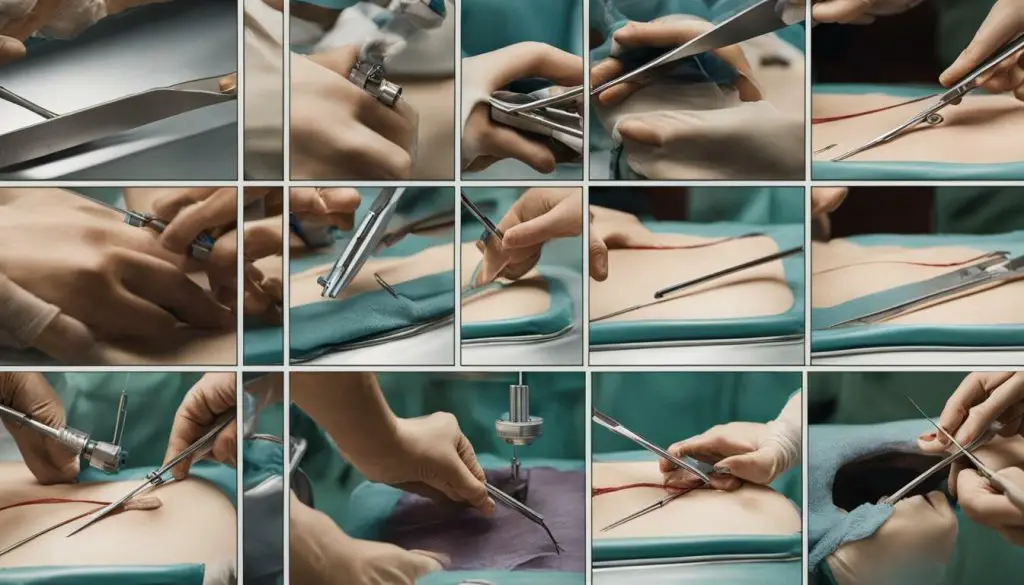Transgender surgery, also known as gender-affirming surgery, is a medical procedure aimed at aligning a person’s physical appearance with their gender identity. It is a transformative journey that individuals undertake to feel more comfortable and authentic in their bodies.
Understanding transgender surgery is crucial in order to support and respect the transgender community. By exploring and defining what this process entails, we can foster empathy and awareness, breaking down barriers and promoting inclusivity.
Transgender surgery procedures encompass a range of options, each tailored to meet the unique needs of individuals. From breast and chest surgeries to genital and facial procedures, the goal is to help individuals achieve a sense of self that aligns with their true identity.
It is important to note that transgender surgery is not without risks. Complications and post-operative issues can arise, requiring medical attention or additional surgeries. However, studies have shown that despite these challenges, many transgender individuals experience increased satisfaction and happiness after undergoing these procedures.
While the number of transgender surgeries has seen a significant increase in recent years, there is still a need for comprehensive data on the long-term effects and outcomes. Continued research is vital to ensure the safety and well-being of individuals undergoing transgender surgery.
In the following sections, we will explore the different types of transgender surgeries, delve into the procedures involved, discuss potential complications, and address the impact and concerns surrounding this life-changing process. By gaining a deeper understanding of transgender surgery, we can contribute to a more accepting and supportive society.
The Types of Transgender Surgeries
There are several types of transgender surgeries, commonly referred to as gender confirmation surgeries, which include procedures tailored to different aspects of transitioning. These surgeries play a crucial role in helping transgender individuals align their physical appearance with their gender identity, contributing to their overall well-being and quality of life.

One of the most common types of transgender surgeries is breast and chest surgeries. These procedures are designed to help individuals achieve a more masculine or feminine chest contour, depending on their desired gender expression. Breast augmentation is often performed for trans women, while trans men may undergo chest reconstruction or removal of breast tissue through a procedure called top surgery.
Another important aspect of transgender surgery is genital surgeries. These complex procedures involve the creation or modification of genitalia to align with an individual’s affirmed gender. The techniques used may include construction of a neovagina or neophallus, and these surgeries require meticulous surgical skill to ensure both aesthetic and functional outcomes.
Facial and cosmetic surgeries also play a significant role in transgender surgery. These procedures focus on feminizing or masculinizing features such as the nose, chin, jawline, and brow ridge. Facial feminization surgery, for example, may include procedures such as rhinoplasty, brow lift, and chin augmentation, while facial masculinization surgery may involve procedures like jaw contouring and cheek augmentation.
Gender Confirmation Surgeries: Options and Considerations
When considering transgender surgeries, it is important to consult with experienced healthcare professionals who specialize in this field. They can provide guidance on the available options and help individuals make informed decisions based on their unique needs and goals. It is also crucial to be aware of the potential risks and complications associated with these surgeries, as well as the need for comprehensive post-operative care and support.
Ultimately, transgender surgeries are an essential component of many individuals’ gender journey, helping them achieve greater congruence between their physical appearance and gender identity. While each person’s path may differ, the ultimate goal is to support transgender individuals in living authentic and fulfilling lives.
Breast and Chest Surgeries: Enhancing Physical Appearance and Gender Identity
Breast and chest surgeries are among the most common procedures performed as part of transgender surgery, and they play a significant role in aligning an individual’s physical appearance with their gender identity. For transgender women, breast augmentation procedures involve the use of implants or fat transfer techniques to create feminine contours and enhance the overall shape and size of the breasts. These surgeries not only help transgender women achieve a more feminine silhouette but also contribute to their self-confidence and sense of identity.
On the other hand, transgender men often undergo chest masculinization surgeries, which involve removing excess breast tissue and contouring the chest to create a more masculine appearance. This procedure is commonly referred to as “top surgery” and may also include nipple grafting to achieve a natural-looking result. For many transgender men, chest masculinization is a crucial step in their transition journey, as it helps alleviate gender dysphoria and allows them to feel more comfortable in their own bodies.

It’s important to note that these surgeries are highly customizable, with options to accommodate individual preferences and desired outcomes. Surgeons work closely with patients to understand their goals and expectations, ensuring that the procedures are tailored to meet their unique needs. By addressing the chest and breast areas, transgender individuals can find a greater sense of alignment between their physical appearance and their gender identity.
The Impact of Breast and Chest Surgeries
The impact of breast and chest surgeries extends far beyond the physical aspect. Studies have shown that transgender individuals who undergo these procedures experience significant improvements in their mental well-being and quality of life. According to a recent survey, over 90% of transgender women reported feeling more confident and comfortable with their bodies after breast augmentation, while more than 80% of transgender men expressed increased satisfaction and reduced distress following chest masculinization.
However, it is crucial to acknowledge the risks and potential complications associated with these surgeries. As with any surgical procedure, there are possibilities of infection, scarring, and adverse reactions to anesthesia. It is essential for individuals considering breast and chest surgeries to consult with experienced surgeons specializing in transgender procedures and to fully understand the risks involved.
Despite the challenges, breast and chest surgeries remain vital steps in the journey towards gender affirmation for many transgender individuals. These procedures not only enhance physical appearance but also have a profound impact on the overall well-being and happiness of transgender individuals, aligning their physical bodies with their true selves.
Table 1: Common Breast and Chest Surgeries
| Procedure | Description |
|---|---|
| Breast Augmentation | Involves the placement of implants or fat transfer techniques to enhance breast size and shape in transgender women. |
| Chest Masculinization | Removal of excess breast tissue and contouring of the chest to create a more masculine appearance in transgender men. |
| Nipple Grafting | A technique commonly performed alongside chest masculinization to achieve a natural-looking result by grafting the nipples. |
Genital Surgeries: Aligning Physical Characteristics with Gender Identity
Genital surgeries are a crucial component of transgender surgery, as they involve aligning a person’s physical characteristics with their gender identity through procedures tailored to their needs. These surgeries aim to create the desired genitalia that align with an individual’s identified gender, and they play a significant role in helping transgender individuals feel more comfortable in their bodies.
One common procedure is known as vaginoplasty, which involves the creation of a vagina for trans women. This complex surgery often utilizes tissue from the penile inversion technique, where the penile skin is reshaped and used to create the vaginal canal. The procedure also includes reconstructing the clitoris to enhance sexual pleasure and sensation.
For trans men, phalloplasty is a common genital surgery. This procedure involves constructing a penis using tissue from various donor sites, such as the forearm or thigh. It also includes attaching nerve and blood vessels to ensure functionality. Though technically challenging, phalloplasty can provide significant improvements in both appearance and function for trans men.
It is important to note that these surgeries come with risks and potential complications. The use of tissue grafts and the complex nature of the procedures can lead to post-operative issues, such as healing problems or infection. Moreover, additional surgeries may be required to refine the results or address any complications that arise.
| Genital Surgery Procedures | Purpose |
|---|---|
| Vaginoplasty | To create a vagina for trans women |
| Phalloplasty | To construct a penis for trans men |
“Genital surgeries are transformative for many transgender individuals, allowing them to align their physical appearance with their gender identity. However, it is crucial to weigh the potential risks and complications before undergoing these procedures,” says Dr. Rachel Johnson, a renowned gender-affirming surgeon.
Despite the risks involved, studies have shown that many transgender individuals experience increased satisfaction and happiness after undergoing genital surgeries. These procedures can have a profound impact on an individual’s well-being and help alleviate body dysphoria. However, given the lack of comprehensive data on long-term effects and outcomes, continued research is essential to ensure the safety and efficacy of these surgeries for transgender individuals.

Facial and cosmetic surgeries are common procedures performed as part of transgender surgery, playing a vital role in enhancing an individual’s gender expression and aligning their physical appearance with their gender identity. These surgeries address the unique needs and preferences of transgender individuals, allowing them to achieve the facial features and overall aesthetic they desire.
One of the most popular facial surgeries is facial feminization surgery (FFS), which aims to soften masculine facial features and create a more feminine appearance. This may involve procedures such as rhinoplasty (nose reshaping), forehead contouring, jaw reshaping, and lip augmentation. FFS can significantly impact an individual’s self-confidence and help them feel more authentically themselves.
On the other hand, facial masculinization surgery (FMS) focuses on enhancing masculine facial features for transgender men. This may involve procedures such as jaw augmentation, cheek and chin implants, and Adam’s apple reduction. FMS can help transgender men align their physical appearance with their gender identity and improve their overall sense of self.
| Facial Surgeries | Procedure |
|---|---|
| Facial Feminization Surgery (FFS) | Rhinoplasty, forehead contouring, jaw reshaping, lip augmentation |
| Facial Masculinization Surgery (FMS) | Jaw augmentation, cheek and chin implants, Adam’s apple reduction |
It’s important to note that facial and cosmetic surgeries for transgender individuals require a highly specialized and experienced surgeon. These procedures are intricate and can have a significant impact on a person’s appearance, so it’s crucial to choose a surgeon who understands the unique needs and goals of transgender patients.

Ultimately, facial and cosmetic surgeries are essential components of transgender surgery, allowing individuals to fully express their gender identity and feel more comfortable in their own skin. These procedures, combined with other types of transgender surgeries, contribute to the overall well-being and quality of life for transgender individuals seeking gender affirmation.
Complications and Post-Op Issues
While transgender surgeries can be life-changing, they also carry risks, and it is crucial to be aware of potential complications and post-operative issues that may arise. These procedures are complex and often involve significant alterations to the body, which can lead to various challenges during the recovery process.
One of the most common post-operative issues is the development of infections at the surgical site. These infections can occur due to factors such as poor wound care, bacterial contamination, or pre-existing health conditions. It is essential for individuals to follow proper hygiene practices and carefully monitor their incisions to minimize the risk of infection.
Pain and discomfort are also common after transgender surgeries. While some degree of pain is expected during the recovery period, severe or prolonged pain should not be ignored and needs medical attention. In some cases, additional surgery may be required to address complications or alleviate persistent pain.
In addition to physical complications, transgender individuals may also experience psychological or emotional challenges following surgery. Some may struggle with body image issues or face difficulty adjusting to their new appearance. It is important for individuals to have a support system in place and seek professional help if they are experiencing mental health concerns.

It is crucial for individuals considering transgender surgery to have a thorough understanding of the potential complications and post-operative issues that can arise. This knowledge will help them make informed decisions about their healthcare journey and better prepare for the challenges that may come their way.
The Impact and Concerns of Transgender Surgery
Transgender surgery has been shown to positively impact individuals’ satisfaction and happiness; however, concerns persist regarding the long-term effects and outcomes due to the limited availability of comprehensive data. Studies have indicated that many transgender individuals experience increased satisfaction and improved mental well-being after undergoing gender-affirming surgeries. These procedures help align their physical appearance with their gender identity, providing a sense of authenticity and congruence.
“I finally feel like my true self,” says Sarah, a trans woman who recently underwent facial feminization surgery. “It’s incredible how this surgery has transformed my life and allowed me to live authentically. I feel more confident and at peace with myself.”
Despite the positive impacts reported by many individuals, concerns remain about the potential long-term effects and outcomes of transgender surgery. The lack of comprehensive data makes it challenging to fully understand the potential risks and benefits associated with these procedures. Researchers and medical professionals continue to advocate for further research in this field to address these concerns.
A recent analysis of transgender surgeries in the United States revealed a significant number of complications and post-operative issues. Up to half of trans men and women who undergo these surgeries experience complications such as infection, scarring, or severe pain that may require additional medical attention or surgeries.
| Type of Surgery | Complication Rate |
|---|---|
| Breast and Chest Surgeries | 35% |
| Genital Surgeries | 42% |
| Facial and Cosmetic Surgeries | 27% |
These findings highlight the importance of comprehensive pre-operative assessments, careful surgical planning, and post-operative care to minimize complications and ensure optimal outcomes for transgender individuals. It is crucial for both healthcare providers and patients to weigh the potential risks and benefits of these surgeries and make informed decisions.

In conclusion, transgender surgery has the potential to greatly enhance the lives of individuals by aligning their physical appearance with their gender identity. However, the limited availability of comprehensive data on long-term effects and outcomes poses an ongoing concern. Further research is necessary to provide a better understanding of the risks, benefits, and long-term implications of these surgeries. By doing so, we can ensure that transgender individuals receive the best possible care and support throughout their surgical journey.
Conclusion
Transgender surgery, or gender-affirming surgery, is a complex and life-changing procedure that can greatly impact an individual’s well-being and happiness. Understanding the different types of surgeries, potential complications, and the need for comprehensive data on long-term effects is crucial for both healthcare professionals and transgender individuals seeking these procedures.
A recent analysis found that the number of transgender surgeries in the United States nearly tripled between 2016 and 2019, indicating an increasing demand for these procedures. The most common surgeries performed are breast and chest surgeries, followed by genital surgeries and facial and cosmetic surgeries. However, it is important to note that these surgeries can be complex and risky, often requiring the use of tissue from other body parts to create the desired genitalia.
Complications after transgender surgery are not uncommon, with up to half of trans men and women experiencing post-operative issues or severe pain that may require medical attention or additional surgery. This highlights the importance of closely monitoring patients during the recovery process and providing appropriate support and care.
While there are risks involved, studies have shown that many transgender individuals report increased satisfaction and happiness after undergoing these surgeries. However, there are concerns about the lack of comprehensive data on the long-term effects and outcomes of these procedures. Further research is needed to better understand the potential long-term physical and psychological impacts of transgender surgery, ensuring that healthcare professionals and patients have access to accurate and evidence-based information.
FAQ
What is transgender surgery?
Transgender surgery, also known as gender-affirming surgery, is aimed at aligning a person’s physical appearance with their gender identity.
What are the most common transgender surgery procedures?
The most common procedures are breast and chest surgeries, followed by genital surgeries and facial and cosmetic surgeries.
Are there any complications after transgender surgery?
Yes, the number of complications after surgery is high, with up to half of trans men and women experiencing post-op issues or severe pain that requires medical attention or additional surgery.
How complex and risky are transgender surgeries?
These surgeries are complex and risky, often involving the use of tissue from other body parts to create the desired genitalia.
Do transgender individuals report increased satisfaction after undergoing surgery?
Yes, studies have shown that many transgender individuals report increased satisfaction and happiness after undergoing these surgeries.
What are the concerns about transgender surgery?
There are concerns about the lack of comprehensive data on the long-term effects and outcomes of these procedures.
Source Links
- https://www.nytimes.com/2023/08/23/health/transgender-surgery.html
- https://www.dailymail.co.uk/health/article-12033765/Just-16-gender-dysphoria-patients-op-half-suffer-life-threatening-complications.html
- https://www.washingtonpost.com/history/2023/06/12/first-transgender-surgery-christine-jorgensen/